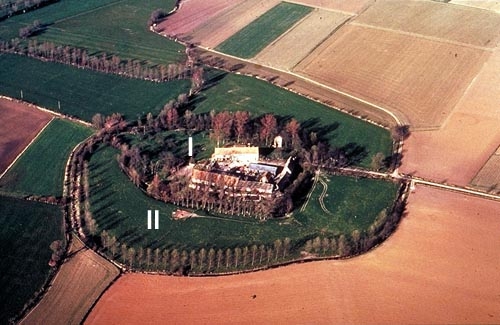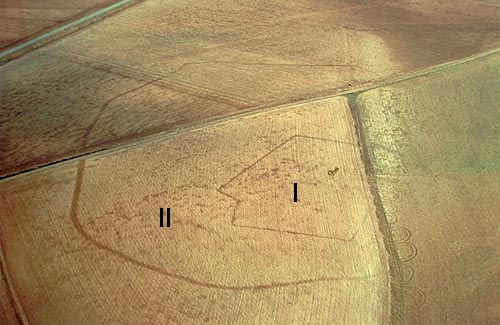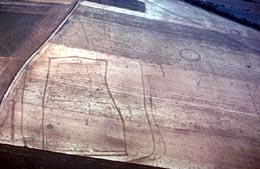- Home
- Discoveries
- Gallic settlements
- The aedeficia
- The major networks of enclosures
In northern France, the enclosure I is built around the house, farm buildings, barns, stables, pigsty, henhouse, and the garden — this is the courtil. The enclosure II is much larger and is called the plant (planted pasture).
A system of type I and II nested enclosures from the Gallic era, which have reappeared thanks to traces of dew remaining in ancient ditches. Soues (Somme).
As soon as aerial prospecting began, use of the airplane revealed very different types of ancient enclosures. Small and very small enclosures, round or square in shape, are ritual and above all funerary enclosures. Large networks of enclosures cover much more land and are often irregularly-shaped; they can be as large as a hectare, and even larger. Of these large enclosures, some are simple and delimited by a single ditch. On the other hand, others are highly complex with multiple ditches demarcating enclosures that are nested and sometimes intertwined. These "enclosure networks" are reminiscent of those belonging to large, traditional farms that are still visible today in the French countryside, especially since they are the same size — and one can see a number of pits both inside and outside. In the immediate vicinity, one can also observe pastures enclosed by hedges, small pits, and overgrown paths. Certainly one is struck by the astonishing similarity of the overall layout of the nested enclosures, whether in a recent farm or in ancient, leveled structures that reappear thanks to the morning dew. One could imagine that one was in the presence of "native farms", isolated and close in structure to more recent traditional farms. This hypothesis was put forward in 1970 (Agache, 1970), and from the initial excavation, the more elaborate of these structures were identified as aedificia.
Since then, vast archaeological digs have been carried out, particularly rescue operations along the paths of train lines and motorways under construction. A number of these vast nested enclosures have been thoroughly excavated, and there is no doubt that most of them belong to protohistoric farms, even if chronologically they extend from the First Iron Age at least as far as the second century CE.
A beautiful example of a Gallic farm at Erondelle (Somme).


